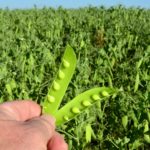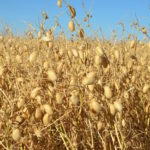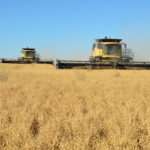When the use of bentazon on pulse crops was threatened due to outdated residue data, U.S. growers turned to the IR-4 Project to generate new data to ensure they could continue applying the herbicide.

Pulses are a group of crops that includes dry peas, chickpeas, lentils and dry beans. Pulses do not include crops that are harvested fresh such as snap peas and succulent green beans. The United Nations Food and Agriculture Organization (FAO) identifies 11 types of pulses grown worldwide. FAO designated 2016 as the International Year of Pulses.
Considered a specialty crop, the U.S. has over 3 million acres of pulses in production. According to Todd Scholz, vice president of research and member services at USA Dry Pea and Lentil Council (USADPLC), U.S growers export about 65 percent of the pulses they produce.
“The growing area for dried peas in North America includes parts of Washington and Idaho and begins in Montana and North Dakota. Production extends north into Canada, including Saskatchewan, Alberta and Manitoba,” Scholz said. “USADPLC’s primary grower members are located in Washington, Idaho, Montana, North Dakota and South Dakota. Canadian growers have three to four times the number of acres of dried peas compared to the U.S. Canada is the biggest exporter of pulses in the world.”
Potential loss of bentazon
Codex Alimentarius was established by the United Nations Food and Agriculture Organization and the World Health Organization in 1963. Through the development of guidelines and food standards by its committees, Codex seeks to protect the health of consumers and ensure fair practices in food trade. One of Codex’s committees, the Codex Committee on Pesticide Residues, establishes the maximum limits for pesticide residues (MRLs) in specific food items or in groups of food.
Bentazon is a post-emergence herbicide used by pulse growers to selectively control broadleaf weeds. It was initially registered in 1975.

In 2014 during the 46th session of the Codex Committee on Pesticide Residues the MRL of 1 part per million established for bentazon by Codex was proposed to be revoked.
“Codex has a registration review process for pesticides,” said Dan Kunkel, senior associate director at the IR-4 Project. “Once data is generated on a chemical it is not registered forever. Codex has a 15-year review cycle. Although some new data had been generated on bentazon since it was first registered, Codex noted that there had not been enough trials according to current guidelines to maintain its MRL standard of 1 ppm for the herbicide. Codex requested new data for a complete data set. Codex has a four-year rule not to remove the standard allowing for new data to be collected.
“Bentazon is a very important herbicide to pulse growers and they wanted to avoid having the MRL revoked by Codex. They needed to defend the standard and they were willing to partially fund IR-4 to generate the data that was needed re-establish the MRL.”
Scholz, who attended the Codex meeting in 2014, knew the impact the loss of bentazon would have on pulse growers. “I was at the Codex meeting when the MRL for bentazon was revoked,” Scholz said. “I knew how important this herbicide is to pulse growers in the United States and Canada. Fortunately there is a mechanism in Codex that allows four years to try to establish the residue data that was lacking. Reinstating the bentazon MRL became the number one priority for the pulse industry. I went to IR-4 and asked if the organization would conduct the trials if the council was able to provide the funds to do the research. At that time I worked with my counterpart at Pulse Canada, Gord Kurbis, to collect the money. Funding was provided by the U.S. and Canadian pulse industries, the herbicide registrant BASF, Washington State Commission on Pesticide Registration and IR-4.”
Conducting additional residue trials
Ken Samoil, who is a research coordinator and study director at IR-4, directed the new bentazon trials. “Codex was going to revoke the MRL because they felt that the data was insufficient,” Samoil said. “With the data from the new field trials IR-4 was going to conduct along with the old trials the data generated would be enough to meet Codex regulations.
“My job as study director is to make sure that the residue studies are done correctly in the field and the lab. I prepare a final report describing what has happened and then submit that with a petition to EPA. In the case of bentazon, the petition also went to Codex. Dan Kunkel handled the Codex petition submission.”
Once the bentazon trials were given a high priority by IR-4, they were put on the schedule to be conducted during 2015.
“This was an unusual study, but not unprecedented,” Samoil said. “There are very few studies that occur like this, in which we are not developing data intended to support a new registration or re-registration within the U.S. Our responsibility is to U.S. growers. U.S. growers export food crops and it was demonstrated to us that growers were going to be hurt by revoking the bentazon MRL.”
Field trials were conducted during 2015 in Idaho, North Dakota, South Dakota, Oregon, Washington and Wisconsin. “The trials were conducted by people who do a number of field trials for IR-4 each year,” Samoil said. “Once the trials were completed, samples were collected and sent to an analytical laboratory. The sample analysis is usually conducted at either a land grant university or USDA lab that IR-4 works with. However, for the bentazon trials the analytical work was done by Smithers Viscient, a private lab in Massachusetts.”
No interruption of bentazon use

Kunkel said the new residue trials conducted by IR-4 did not cause any changes to be made to the bentazon (Basagran) label.
“The registrant was very supportive of the MRL trials,” Kunkel said. “The label remained the same with a 30-day treatment to harvest interval for pulse crops. Growers cannot spray bentazon the last 30 days before the crop is harvested. Otherwise growers may face a residue violation.
“One thing that occurred during the trials is that the residues were a little higher than we expected. Therefore, IR-4 had to request that EPA raise the tolerance level (MRL) from 1 ppm to 3 ppm, which also matches the Canadian MRL. The registrant was very supportive of EPA raising the tolerance level to 3 ppm.”
Samoil said it is important that the MRLs set in the United States match those in other countries. “Whenever possible when IR-4 has developed data, we use a spread sheet devised in part by EPA to calculate what a tolerance or MRL should be,” he said. “There is also a need for MRLs be the same in all countries. Having the same MRLs avoids growers facing problems shipping their crops so that they are legal in different countries.
“Canada set its MRL at 3 ppm, which was higher than all of the residues in the IR-4 trials as was the case with the earlier studies that supported the initial registration. The decision was made to propose a new tolerance in the U.S. of 3 ppm as well as proposing to Codex that the international MRL be set at 3 ppm.”
Kunkel said even though bentazon was already registered, EPA had to conduct all of the dietary risk assessments and other procedures to make sure that the public is protected. “We had to submit an entirely separate tolerance request to Codex,” Kunkel said. “The number from the MRL calculator is the same, but then Codex runs it through its human diet calculations. In the U.S. there may be three or four population diets. However, in Codex they look at 17 different diets. The risk assessment and dietary exposure numbers are a little different, but with bentazon that wasn’t a problem in either case. Codex does a completely independent review of EPA.
“The increase in the MRL is really transparent to the growers. This is handled by the regulatory agencies. The good thing is through the pulse industry and IR-4 working together the growers didn’t lose the use of bentazon, which is an extremely important tool for them.”
For more: USA Dry Pea and Lentil Council, (208) 882-3023.
David Kuack is a freelance technical writer in Fort Worth, Texas; dkuack@gmail.com.
